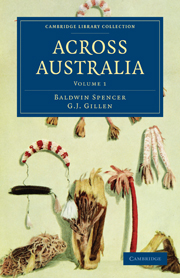CHAPTER I
Published online by Cambridge University Press: 26 April 2011
Summary
It is exactly fifty years since McDouall Stuart first crossed Australia. Could he now revisit the scene of his explorations he would find the Central country, save for the telegraph line with its isolated stations, practically unchanged. He might, at long intervals, come across a hut forming the home of one or two white men managing an outlying cattle-run. In the heart of the Macdonnell Ranges he would find a minute township called after himself, and away to the east of his track, he would hear of the existence of a mere handful of miners, the relics of a gold rush, on the Arltunga field. Otherwise he would find the vast centre of the continent as wild and empty as it was when first he toiled across.
In 1872, the opening of the telegraph line–the building of which was gallantly undertaken, single handed, by South Australia–marked a very distinct stage in the history, not only of that State, but of Australia. The route followed was practically that of McDouall Stuart, and for thirty years it formed Australia's only means of telegraphic communication with the outside world. Gradually the railway pushed northward from Adelaide, first of all to Terowie, the termination of the broadgauge line and, it may be added, the northern end of comfort, so far as railway travelling is concerned in South Australia.
- Type
- Chapter
- Information
- Across Australia , pp. 1 - 7Publisher: Cambridge University PressPrint publication year: 2010First published in: 1912



